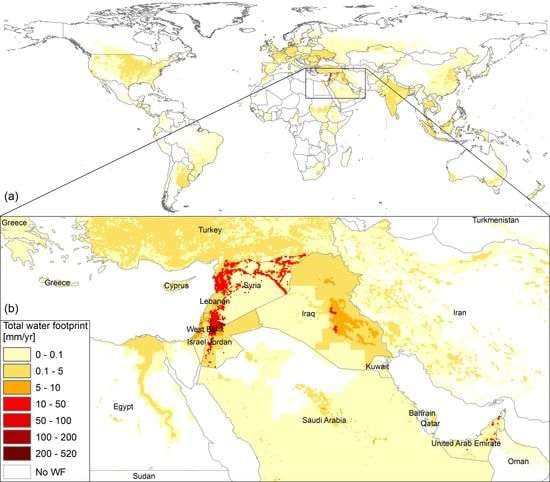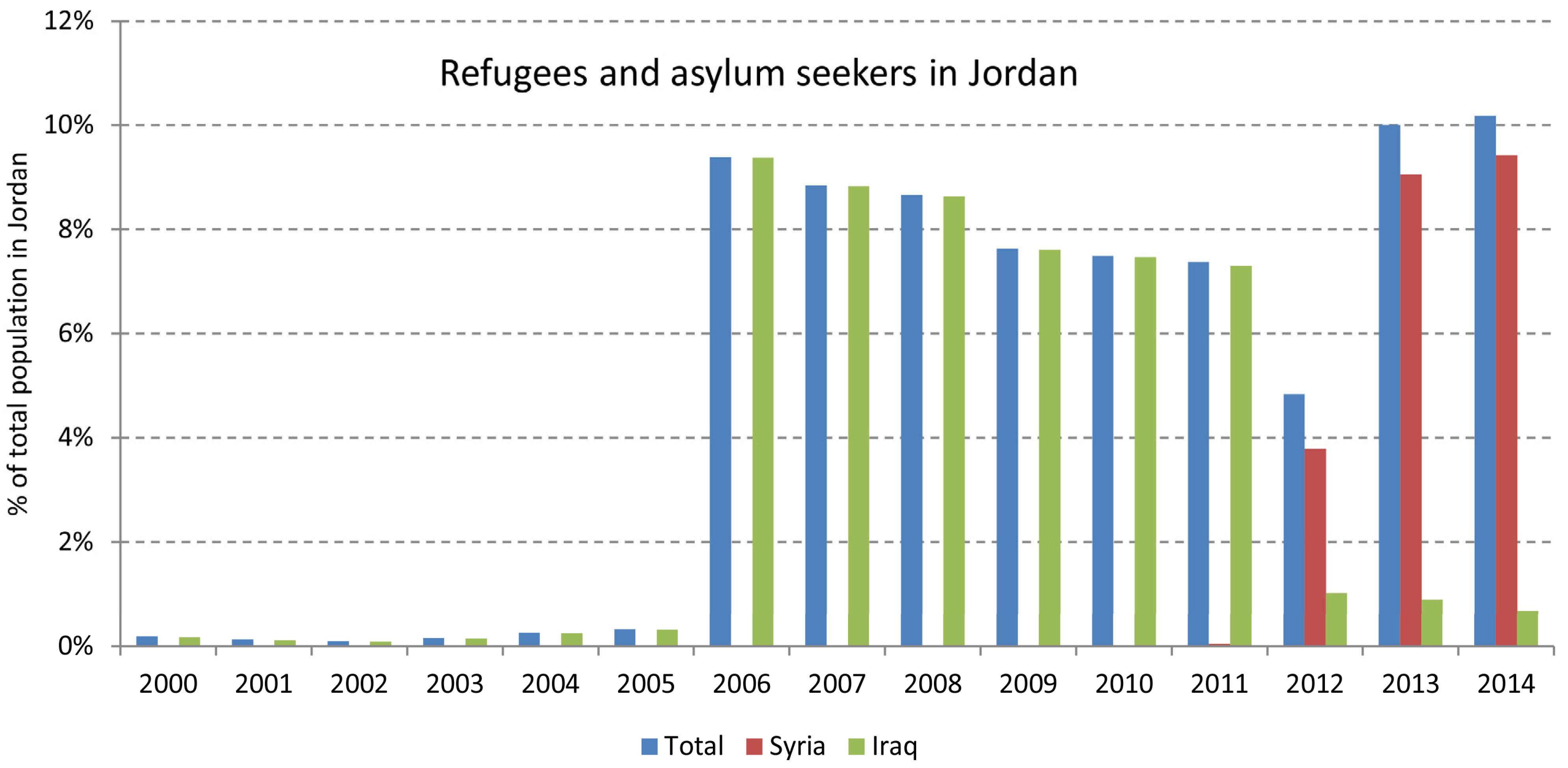Mitigating the Risk of Extreme Water Scarcity and Dependency: The Case of Jordan
Abstract
:1. Introduction
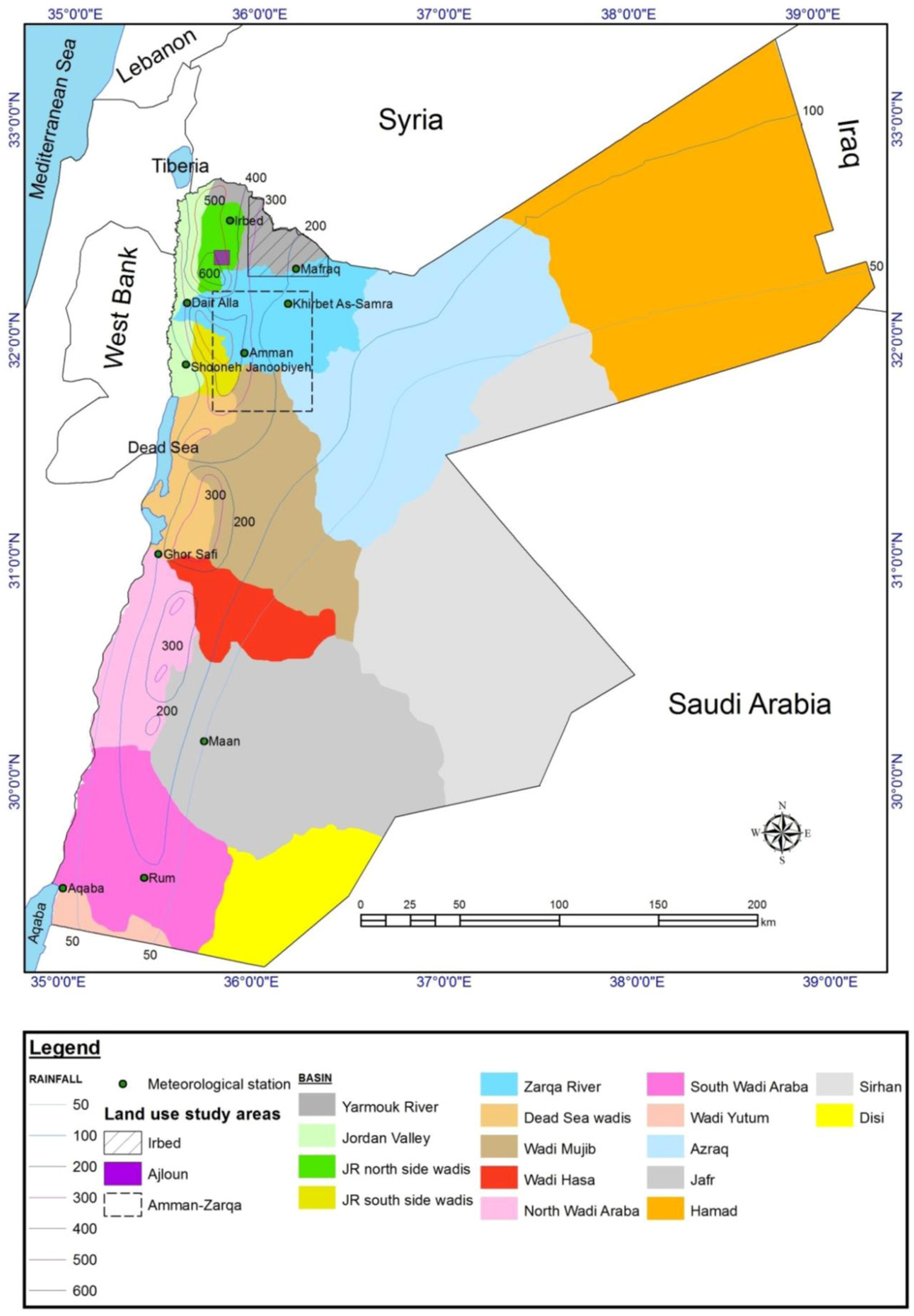
2. Methods and Data
3. The Unsustainability of Water Consumption and Pollution in Jordan
3.1. The Water Footprint of Activities in Jordan
| Activity | Green Water Footprint 1 | Blue Groundwater Footprint 2 | Blue Surface Water Footprint 2 | Total Blue Water Footprint 1,3 | Gray Water Footprint 1 | Total Water Footprint |
|---|---|---|---|---|---|---|
| Crop production | 493 | 263 | 143 | 406 | 54.3 | 953 |
| Grazing | 277 | 277 | ||||
| Animal water supply | 1.4 | 9.9 | 11.3 | 11.3 | ||
| Industrial production | 36.5 | 0.1 | 1.9 | 17.5 | 19.4 | |
| Domestic water supply | 232 | 5.9 | 29.1 | 155 | 185 | |
| Total | 770 | 533 | 159 | 449 | 227 | 1446 |
| Product | Green VWE | Blue VWE | Gray VWE | Total VWE | % of Total |
|---|---|---|---|---|---|
| Seed cotton | 270 | 149 | 53.8 | 473 | 45% |
| Animal products | 228 | 49.8 | 20.7 | 298 | 29% |
| Industrial products | 0.0 | 6.8 | 115 | 121 | 12% |
| Tomatoes | 5.9 | 11.9 | 0.0 | 17.7 | 2% |
| Wheat | 11.5 | 5.0 | 0.9 | 17.4 | 2% |
| Olives | 7.3 | 4.6 | 1.5 | 13.4 | 1% |
| Oil palm fruit | 8.3 | 0.0 | 0.3 | 8.6 | 1% |
| Artichokes | 3.8 | 2.9 | 0.0 | 6.7 | 1% |
| Papayas | 5.4 | 0.5 | 0.3 | 6.3 | 1% |
| Other crops | 51.7 | 26.3 | 5.4 | 83.4 | 8% |
| Total export | 592 | 256 | 198 | 1046 | 100% |
3.2. Blue Water Scarcity: Actual versus Maximum Sustainable Blue Water Footprint
| Water Resource | Water Footprint 1 (106 m³/year) | Water Availability 2 (106 m³/year) | Water Scarcity 1 (−) | Water Scarcity Level |
|---|---|---|---|---|
| Total (surface and groundwater) | 449 | 650 | 0.69 | Severe |
| Groundwater | 533 | 277 | 1.92 | Overexploited |
3.3. Water Pollution Level: Actual versus Maximum Sustainable Gray Water Footprint
| Water Footprint and Pollution Level | Value |
|---|---|
| Total gray water footprint | 227 × 106 m³/year |
| Maximum sustainable gray water footprint | 201 × 106 m³/year |
| Water pollution level | 1.13 |
4. Jordan’s Dependency on Foreign Water Resources
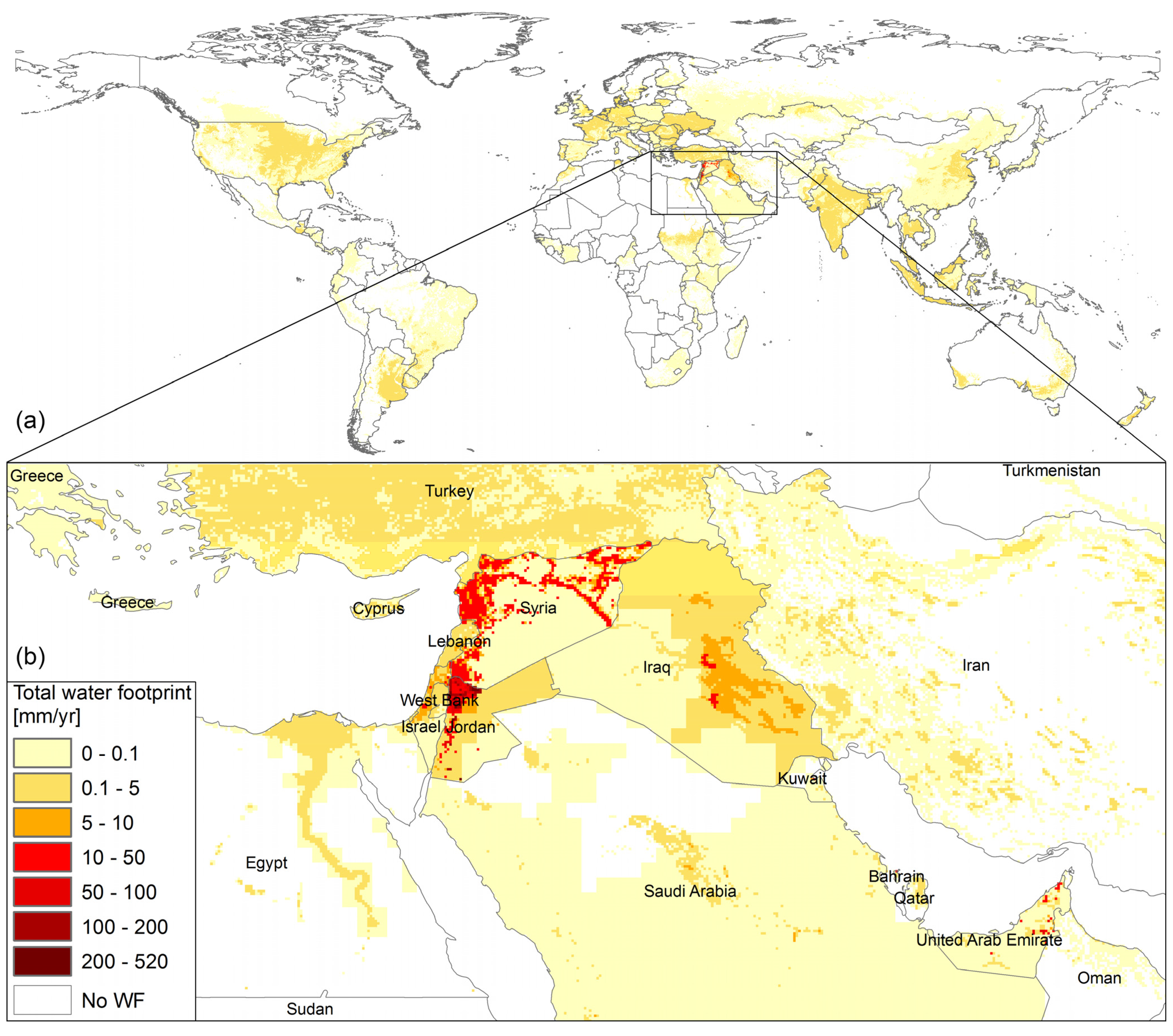
| Product | Green VWI | Blue VWI | Gray VWI | Total VWI | % of total |
|---|---|---|---|---|---|
| Barley | 1067 | 217 | 155 | 1439 | 21% |
| Wheat | 937 | 63 | 102 | 1102 | 16% |
| Animal products | 524 | 66 | 17 | 607 | 9% |
| Oil palm fruit | 524 | 0 | 28 | 551 | 8% |
| Cotton | 221 | 169 | 107 | 497 | 7% |
| Soybeans | 454 | 14 | 9 | 477 | 7% |
| Maize | 367 | 20 | 57 | 444 | 7% |
| Sugar cane | 212 | 70 | 17 | 300 | 4% |
| Other crops | 626 | 259 | 67 | 952 | 14% |
| Industrial products | 0 | 23 | 319 | 342 | 5% |
| Total import | 4933 | 902 | 878 | 6712 | 100% |
| Country | Green VWI | Blue VWI | Gray VWI | Total VWI | Major Products |
|---|---|---|---|---|---|
| USA | 697 | 88 | 123 | 908 | Wheat–66%, maize–16%, rice–8% |
| Syria | 626 | 92 | 122 | 840 | Barley–78%, animal products–4% |
| Argentina | 641 | 11 | 31 | 683 | Wheat–25%, maize–38%, soybean–35% |
| India | 434 | 35 | 29 | 498 | Animal products–40%, soybean–34%, coffee–7%, wheat–6%, cotton–4% |
| Iraq | 172 | 222 | 156 | 550 | Barley–69%, industrial products–29% |
| Malaysia | 319 | 0.5 | 14 | 333 | Oil palm–97% |
| Indonesia | 238 | 0.1 | 17 | 255 | Oil palm–88% |
| China | 133 | 22 | 83 | 239 | Cotton–71%, industrial products–14%, animal products–6% |
| Turkey | 172 | 21 | 25 | 218 | Wheat–41%, barley–29%, cheakpeas–13%, cotton–7% |
| Ukraine | 173 | 4 | 30 | 208 | Barley–60%, sunflower seed–16%, industrial products–14%, wheat–9%, |
| Australia | 93 | 41 | 3 | 138 | Animal products–53%, rice–32%, barley–12% |
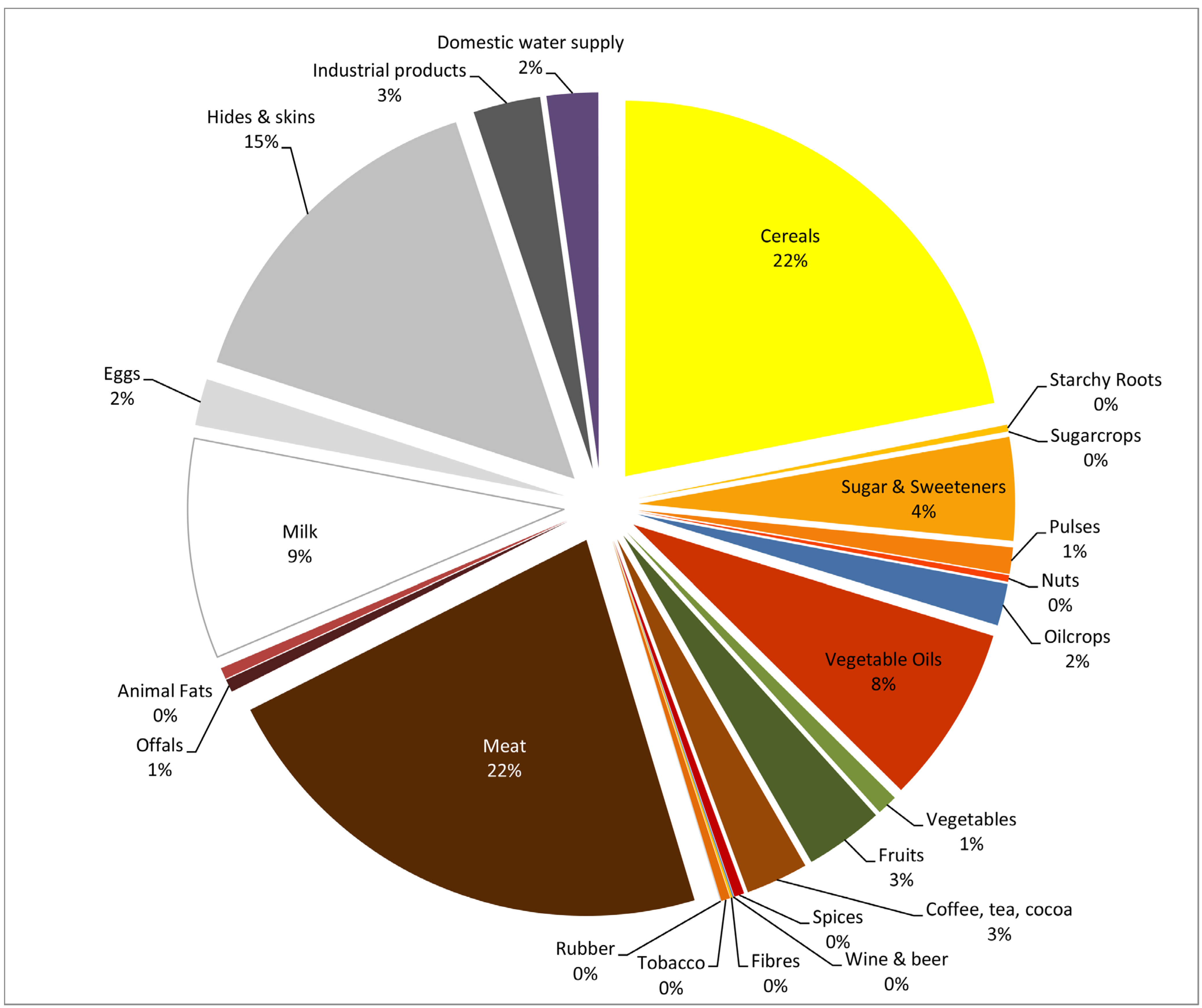
5. Options to Respond to Jordan’s Domestic Water Problems and External Water Dependency
5.1. Increasing Water Availability
5.1.1. Dams for Inter-Seasonal Water Storage
5.1.2. Disi Water Conveyance Project
5.1.3. Desalination
5.1.4. Water Harvesting and Productive Use of Precipitation
5.1.5. Treatment and Reuse of Wastewater
5.2. Reducing Water Demand per Unit of Product
5.2.1. Rationalization of Irrigation Water Use
5.2.2. Reduce Green and Blue Water Footprints of Crops: Benchmarks
5.2.3. Reduce Gray Water Footprints: Prevent and Treat
5.2.4. Rehabilitation of Public Water Supply Network
5.3. Reducing Water Demand by Changing Production and Consumption Patterns
5.3.1. Maximum Sustainable Water Footprints: Caps and Permits
5.3.2. Produce High Value-Added Products and Crops: Allocation Efficiency
5.3.3. Change Consumption Patterns
5.4. Reducing Risks Related to the External Water Dependency
5.5. International Assistance in Taking in Refugees
5.6. Positioning Current Water Policy in Jordan
6. Conclusions
- Even while taking into account the return flows, blue water scarcity in Jordan is severe;
- Groundwater consumption is nearly double the groundwater availability;
- Water pollution aggravates blue water scarcity;
- While Jordan’s dependence on trans-boundary resources is already large (34%), its dependency on external water resources through trade is much larger, with 86% of the water consumption associated with the production of products and commodities consumed by the Jordan population taking place in foreign countries all over the world.
- Do not tap into fossil groundwater resources; use only in urgent times, in low amounts and at low frequencies.
- Drive desalination projects with sustainable solar and wind energy.
- Investigate and implement options for water harvesting and productive use of rainfall to overcome water shortages on the small scale.
- Prevent pollution, treat inevitable waste streams, and possibly reuse wastewater flows, but consider that treated wastewater is not a new freshwater resource in addition to ground- and surface water and desalinated water.
- Develop WF benchmarks for crops and products that reflect reasonable levels of water consumption per unit of production and work towards achieving those benchmarks by focusing on smart and efficient irrigation scheduling and improved soil and crop management.
- Cap the WF in each river basin and aquifer to the maximum sustainable WF, focusing on groundwater first, while managing the risks of averted impact on surface water.
- Increase allocation efficiency by making sure domestic water demand is met and using the remaining available water below the maximum sustainable level for the production of high value-added products and crops with relatively low WFs for export.
- Use the revenue obtained by export to finance the inevitable imports of water-intensive products and commodities from a diverse number of countries that are under a significantly lower degree of water scarcity than Jordan.
- Stimulate a change towards consumption patterns with a lower WF, e.g., by means of introducing meat-free days and product labeling.
- The international community should assist Jordan in taking in the large numbers of refugees from neighboring conflict regions, to reduce the domestic water demand.
Acknowledgments
Author Contributions
Conflicts of Interest
References
- Scott, C.A.; El-Naser, H.; Hagan, R.E.; Hijazi, A. Facing water scarcity in Jordan—Reuse, demand reduction, energy, and transboundary approaches to assure future water supplies. Water Int. 2003, 28, 209–216. [Google Scholar] [CrossRef]
- Mohsen, M.S. Water strategies and potential of desalination in Jordan. Desalination 2007, 203, 27–46. [Google Scholar] [CrossRef]
- Van Aken, M.; Molle, F.; Venot, J.P. Squeezed dry: The historical trajectory of the Lower Jordan River Basin. In River Basin Trajectories: Societies, Environments and Development; Molle, F., Wester, P., Eds.; CABI: Colombo, Sri Lanka; International Water Management Institute (IWMI): Wallingford, UK, 2009; pp. 20–46. [Google Scholar]
- Alqadi, K.A.; Kumar, L. Water policy in Jordan. Int. J. Water Resour. Dev. 2014, 30, 322–334. [Google Scholar] [CrossRef]
- Alqadi, K.A.; Kumar, L. Water issues in the Kingdom of Jordan: A brief review with reasons for declining quality. J. Food Agric. Environ. 2011, 9, 1019–1023. [Google Scholar]
- Hadadin, N.; Qaqish, M.; Akawwi, E.; Bdour, A. Water shortage in Jordan—Sustainable solutions. Desalination 2010, 250, 197–202. [Google Scholar] [CrossRef]
- Becker, N.; Helgeson, J.; Katz, D. Once there was a river: A benefit-cost analysis of rehabilitation of the Jordan River. Reg. Environ. Chang. 2014, 14, 1303–1314. [Google Scholar] [CrossRef]
- Hoekstra, A.Y.; Mekonnen, M.M. The water footprint of humanity. Proc. Natl. Acad. Sci. 2012, 109, 3232–3237. [Google Scholar] [CrossRef] [PubMed]
- Medzini, A.; Wolf, A.T. Towards a Middle East at peace: Hidden issues in Arab-Israeli hydropolitics. Int. J. Water Resour. Dev. 2004, 20, 193–204. [Google Scholar] [CrossRef]
- Schenker, D. Twenty Years of Israeli-Jordanian Peace: A Brief Assessment; The Washington Institute for Near East Policy: Washington, DC, USA, 2014. [Google Scholar]
- Namrouqa, H. Yarmouk water sharing violations require political solution. Availible online: http://www.jordantimes.com/news/local/yarmouk-water-sharing-violations-require-political-solution%E2%80%99 (accessed on 2 April 2015).
- Gleick, P.H. Water, drought, climate change, and conflict in Syria. Weather Clim. Soc. 2014, 6, 331–340. [Google Scholar] [CrossRef]
- De Chatel, F. The role of drought and climate change in the Syrian uprising: Untangling the triggers of the revolution. Middle East. Stud. 2014, 50, 521–535. [Google Scholar] [CrossRef]
- Abu-Shams, I.; Rabadi, A. The strategy of restructuring and rehabilitating the Greater Amman water network. Int. J. Water Resour. Dev. 2003, 19, 173–183. [Google Scholar] [CrossRef]
- Talozi, S.; Al Sakaji, Y.; Altz-Stamm, A. Towards a water-energy-food nexus policy: Realizing the blue and green virtual water of agriculture in Jordan. Int. J. Water Resour. Dev. 2015, 31, 461–482. [Google Scholar] [CrossRef]
- Toernros, T.; Menzel, L. Addressing drought conditions under current and future climates in the Jordan River region. Hydrol. Earth Syst. Sci. 2014, 18, 305–318. [Google Scholar] [CrossRef]
- Jaber, J.O.; Mohsen, M.S. Evaluation of non-conventional water resources supply in Jordan. Desalination 2001, 136, 83–92. [Google Scholar] [CrossRef]
- Abdulla, F.; Eshtawi, T.; Assaf, H. Assessment of the impact of potential climate change on the water balance of a semi-arid watershed. Water Resour. Manag. 2009, 23, 2051–2068. [Google Scholar] [CrossRef]
- Kelley, C.P.; Mohtadi, S.; Cane, M.A.; Seager, R.; Kushnir, Y. Climate change in the Fertile Crescent and implications of the recent Syrian drought. Proc. Natl. Acad. Sci. USA 2015, 112, 3241–3246. [Google Scholar] [CrossRef] [PubMed]
- Ammari, T.G.; Tahhan, R.; Abubaker, S.; Al-Zu’Bi, Y.; Tahboub, A.; Ta’Any, R.; Abu-Romman, S.; Al-Manaseer, N.; Stietiya, M.H. Soil salinity changes in the Jordan Valley potentially threaten sustainable irrigated agriculture. Pedosphere 2013, 23, 376–384. [Google Scholar] [CrossRef]
- Haddadin, M.J. Irrigation technology and water conservation in Jordan. In The Management of Water Quality and Irrigation Technologies; Albiac, J., Dinar, A., Eds.; Earthscan: London, UK; Sterling, CA, USA, 2009; pp. 137–152. [Google Scholar]
- Haddadin, M.J. Water: Triggering cooperation between former enemies. Water Int. 2011, 36, 178–185. [Google Scholar] [CrossRef]
- Ministry of Water and Irrigation (MWI). Water for Life: Jordan’s Water Strategy 2008–2022; Ministry of Water and Irrigation: Amman, Jordan, 2009.
- Kliot, N. Water Resources and Conflict in the Middle East, 5th ed.; Routledge: Abingdon, UK, 2005. [Google Scholar]
- Abu Qdais, H. Environmental impacts of the mega desalination project: The Red-Dead Sea conveyor. Desalination 2008, 220, 16–23. [Google Scholar] [CrossRef]
- Abu Ghazleh, S.; Hartmann, J.; Jansen, N.; Kempe, S. Water input requirements of the rapidly shrinking Dead Sea. Naturwissenschaften 2009, 96, 637–643. [Google Scholar] [CrossRef] [PubMed]
- Schyns, J.F.; Hoekstra, A.Y.; Booij, M.J. Review and classification of indicators of green water availability and scarcity. Hydrol. Earth Syst. Sci. Discuss. 2015, 12, 5519–5564. [Google Scholar] [CrossRef]
- Al-Zu’bi, Y. Effect of irrigation water on agricultural soil in Jordan valley: An example from arid area conditions. J. Arid Environ. 2007, 70, 63–79. [Google Scholar] [CrossRef]
- Venot, J.P.; Molle, F. Groundwater depletion in the Jordan Highlands: Can pricing policies regulate irrigation water use? Water Resour. Manag. 2008, 22, 1925–1941. [Google Scholar] [CrossRef]
- El-Naqa, A.; Al-Shayeb, A. Groundwater protection and management strategy in Jordan. Water Resour. Manag. 2009, 23, 2379–2394. [Google Scholar] [CrossRef]
- Alqadi, K.A.; Kumar, L. Are there monthly variations in water quality in the Amman, Zarqa and Balqa regions, Jordan? Comput. Water Energy Environ. Eng. 2013, 2. [Google Scholar] [CrossRef]
- Al-Ansari, N.; Alibrahiem, N.; Alsaman, M.; Knutsson, S. Water demand management in Jordan. Engineering 2014, 6. [Google Scholar] [CrossRef]
- Alqadi, K.A.; Kumar, L.; Khormi, H.M. Mapping hotspots of underground water quality based on the variation of chemical concentration in Amman, Zarqa and Balqa regions, Jordan. Environ. Earth Sci. 2014, 71, 2309–2317. [Google Scholar] [CrossRef]
- Al-Bakri, J.T.; Salahat, M.; Suleiman, A.; Suifan, M.; Hamdan, M.R.; Khresat, S.; Kandakji, T. Impact of Climate and Land Use Changes on Water and Food Security in Jordan: Implications for Transcending “The Tragedy of the Commons”. Sustainability 2013, 5, 724–748. [Google Scholar] [CrossRef]
- World Bank. World Development Indicators: Jordan; The World Bank Group: Washington, DC, USA; Availible online: http://databank.worldbank.org/data/table/source/2?country=JOR&series=&period (accessed on 20 July 2015).
- United Nations High Commissioner for Refugees (UNHCR), UNHCR Statistical Online Population Database; UNHCR. Availible online: www.unhcr.org/statistics/populationdatabase (data extracted on 20 July 2015).
- Hoekstra, A.Y.; Chapagain, A.K.; Aldaya, M.M.; Mekonnen, M.M. The Water Footprint Assessment Manual: Setting the Global Standard; Earthscan: London, UK, 2011. [Google Scholar]
- Mekonnen, M.M.; Hoekstra, A.Y. The green, blue and grey water footprint of crops and derived crop products. Hydrol. Earth Syst. Sci. 2011, 15, 1577–1600. [Google Scholar] [CrossRef]
- Mekonnen, M.M.; Hoekstra, A.Y. National Water Footprint Accounts: The Green, Blue and Grey Water Footprint of Production and Consumption; UNESCO-IHE: Delft, The Netherlands, 2011. [Google Scholar]
- Schyns, J.F.; Hoekstra, A.Y. The added value of water footprint assessment for national water policy: A case study for Morocco. PLoS ONE 2014, 9. [Google Scholar] [CrossRef]
- Food And Agriculture Organization Of The United Nations. AQUASTAT: Glossary. Available online: http://www.fao.org/nr/water/aquastat/data/glossary/search.html?lang=en (accessed on 17 July 2015).
- Ministry of Water and Irrigation (MWI). Jordan Water Sector: Facts and Figures 2013; Ministry of Water and Irrigation: Amman, Jordan, 2013.
- Dottridge, J.; Abu Jaber, N. Groundwater resources and quality in northeastern Jordan: Safe yield and sustainability. Appl. Geogr. 1999, 19, 313–323. [Google Scholar] [CrossRef]
- Sophocleous, M. From safe yield to sustainable development of water resources—The Kansas experience. J. Hydrol. 2000, 235, 27–43. [Google Scholar] [CrossRef]
- Hoekstra, A.Y.; Mekonnen, M.M.; Chapagain, A.K.; Mathews, R.E.; Richter, B.D. Global monthly water scarcity: Blue water footprints versus blue water availability. PLoS ONE 2012. [Google Scholar] [CrossRef] [PubMed]
- Nortcliff, S.; Carr, G.; Potter, R.B.; Darmame, K. Jordan’s Water Resources: Challenges for the Future; Geography, The University of Reading: Reading, UK, 2008. [Google Scholar]
- Food And Agriculture Organization Of The United Nations. FAOSTAT: Trade. Availible online: http://faostat3.fao.org/ (accessed on 5 January 2015).
- Ammary, B.Y. Wastewater reuse in Jordan: Present status and future plans. Desalination 2007, 211, 164–176. [Google Scholar] [CrossRef]
- Al-Taani, A. Seasonal variations in water quality of Al-Wehda Dam north of Jordan and water suitability for irrigation in summer. Arab J. Geosci. 2013, 6, 1131–1140. [Google Scholar] [CrossRef]
- Mekonnen, M.M.; Hoekstra, A.Y. The blue water footprint of electricity from hydropower. Hydrol. Earth Syst. Sci. 2012, 16, 179–187. [Google Scholar] [CrossRef]
- Goldsmith, E.; Hildyard, N. Water losses: Exceeding gains? In The Social and Environmental Effects of Large Dams: Overview; Wadebridge Ecological Centre: Cornwall, UK, 1984; p. 1. [Google Scholar]
- Namrouqa, H. King Inaugurates Disi Water Project. Availible online: http://www.jordantimes.com/news/local/king-inaugurates-disi-water-project (accessed on 7 May 2015).
- Aulong, S.; Bouzit, M.; Doerfliger, N. Cost-effectiveness analysis of water management measures in two river basins of Jordan and Lebanon. Water Resour. Manag. 2009, 23, 731–753. [Google Scholar] [CrossRef]
- Ministry of Water and Irrigation (MWI). Annual Report 2012; Ministry of Water and Irrigation: Amman, Jordan, 2012.
- Salameh, E.; Alraggad, M.; Tarawneh, A. Disi water use for irrigation—A false decision and its consequences. CLEAN Soil Air Water 2014, 42, 1681–1686. [Google Scholar] [CrossRef]
- World Bank. The Hashemite Kingdom of Jordan: Water Sector Review; No. 17095–JO; The World Bank Group: Washington, DC, USA, 1997. [Google Scholar]
- Vengosh, A.; Hirschfeld, D.; Vinson, D.; Dwyer, G.; Raanan, H.; Rimawi, O.; Al-Zoubi, A.; Akkawi, E.; Marie, A.; Haquin, G.; et al. High naturally occurring radioactivity in fossil groundwater from the Middle East. Environ. Sci. Technol. 2009, 43, 1769–1775. [Google Scholar] [CrossRef] [PubMed]
- Al-Khalidi, S. Jordan, Israel Agree $900 million Red Sea-Dead Sea Project. Available online: http://www.reuters.com/article/2015/02/26/us-mideast-economy-water-idUSKBN0LU23Z20150226 (accessed on 7 May 2015).
- Beyth, M. The Red Sea and the Mediterranean-Dead Sea canal project. Desalination 2007, 214, 365–371. [Google Scholar] [CrossRef]
- Al-Omari, A.; Salman, A.; Karablieh, E. The Red Dead Canal project: An adaptation option to climate change in Jordan. Desalin. Water Treat. 2013, 52, 2833–2840. [Google Scholar] [CrossRef]
- Al-Omari, A.S.; Al-Karablieh, E.K.; Al-Houri, Z.M.; Salman, A.Z.; Al-Weshah, R.A. Irrigation water management in the Jordan Valley under water scarcity. Fresenius Environ. Bull. 2015, 24, 1176–1188. [Google Scholar]
- U.S. Energy Information Administration (EIA). Jordan: International energy data and analysis. Available online: www.eia.gov/beta/international/country.cfm?iso=JOR (accessed on 7 May 2015).
- Abdulla, F.A.; Al-Shareef, A.W. Roof rainwater harvesting systems for household water supply in Jordan. Desalination 2009, 243, 195–207. [Google Scholar] [CrossRef]
- Alfarra, A.; Kemp-Benedict, E.; Hötzl, H.; Sader, N.; Sonneveld, B. A framework for wastewater reuse in Jordan: Utilizing a modified wastewater reuse index. Water Resour. Manag. 2011, 25, 1153–1167. [Google Scholar] [CrossRef]
- Sowers, J.; Vengosh, A.; Weinthal, E. Climate change, water resources, and the politics of adaptation in the Middle East and North Africa. Clim. Chang. 2011, 104, 599–627. [Google Scholar] [CrossRef]
- Batarseh, M.; Rawajfeh, A.; Ioannis, K.; Prodromos, K. Treated municipal wastewater irrigation impact on olive trees (Olea Europaea L.) at Al-Tafilah, Jordan. Water Air Soil Pollut 2011, 217, 185–196. [Google Scholar] [CrossRef]
- Carr, G.; Potter, R.B. Towards effective water reuse: Drivers, challenges and strategies shaping the organisational management of reclaimed water in Jordan. Geogr. J. 2013, 179, 61–73. [Google Scholar] [CrossRef]
- Carr, G.; Potter, R.B.; Nortcliff, S. Water reuse for irrigation in Jordan: Perceptions of water quality among farmers. Agric. Water Manag. 2011, 98, 847–854. [Google Scholar] [CrossRef]
- Ramirez, O.A.; Ward, F.A.; Al-Tabini, R.; Phillips, R. Efficient water conservation in agriculture for growing urban water demands in Jordan. Water Policy 2011, 13, 102–124. [Google Scholar] [CrossRef]
- Doppler, W.; Salman, A.Z.; Al-Karablieh, E.K.; Wolff, H.P. The impact of water price strategies on the allocation of irrigation water: The case of the Jordan Valley. Agric. Water Manag. 2002, 55, 171–182. [Google Scholar] [CrossRef]
- Al-Karablieh, E.K.; Salman, A.Z.; Al-Omari, A.S.; Wolff, H.P.; Anton, T. Estimation of the economic value of irrigation water in Jordan. J. Agric. Sci. Technol. 2012, 2, 487–497. [Google Scholar]
- Molle, F.; Venot, J.P.; Hassan, Y. Irrigation in the Jordan Valley: Are water pricing policies overly optimistic? Agric. Water Manag. 2008, 95, 427–438. [Google Scholar] [CrossRef]
- Comair, G.F.; Gupta, P.; Ingenloff, C.; Shin, G.; McKinney, D.C. Water resources management in the Jordan River Basin. Water Environ. J. 2013, 27, 495–504. [Google Scholar] [CrossRef]
- Shatanawi, M.; Fardous, A.; Mazahrih, N.; Duqqah, M. Irrigation system performance in Jordan. Options Méditerr. Ser. B 2005, 52, 123–132. [Google Scholar]
- Food And Agriculture Organization Of The United Nations. Aquastat Country Fact Sheet: Jordan; Food and Agriculture Organization of the United Nations: Rome, Italy, 2014. [Google Scholar]
- Hoekstra, A.Y. Sustainable, efficient, and equitable water use: The three pillars under wise freshwater allocation. Wiley Interdiscip. Rev. Water 2014, 1, 31–40. [Google Scholar] [CrossRef]
- Hoekstra, A.Y. The Water Footprint of Modern Consumer Society; Routledge: London, UK, 2013. [Google Scholar]
- Hoekstra, A.Y.; Wiedmann, T.O. Humanity’s unsustainable environmental footprint. Science 2014, 344, 1114–1117. [Google Scholar] [CrossRef] [PubMed]
- Al-Weshah, R.A. Optimal use of irrigation water in the Jordan Valley: A case study. Water Resour. Manag. 2000, 14, 327–338. [Google Scholar] [CrossRef]
- Abu-Sharar, T.; Al-Karablieh, E.; Haddadin, M. Role of virtual water in optimizing water resources management in Jordan. Water Resour. Manag. 2012, 26, 3977–3993. [Google Scholar] [CrossRef]
- Zeitoun, M.; Allan, T.; Al Aulaqi, N.; Jabarin, A.; Laamrani, H. Water demand management in Yemen and Jordan: Addressing power and interests. Geogr. J. 2012, 178, 54–66. [Google Scholar] [CrossRef] [PubMed]
- Haddadin, M.J. Exogenous Water: A Conduit to Globalization of Water Resources; UNESCO-IHE: Delft, The Netherlands, 2003; pp. 159–169. [Google Scholar]
- Chapagain, A.K.; Hoekstra, A.Y. Virtual Water Flows Between Nations in Relation to Trade in Livestock and Livestock Products; UNESCO-IHE: Delft, The Netherlands, 2003. [Google Scholar]
- Hoekstra, A.Y.; Hung, P.Q. Globalisation of water resources: International virtual water flows in relation to crop trade. Glob. Environ. Chang. Human Policy Dimens. 2005, 15, 45–56. [Google Scholar] [CrossRef]
- Hoekstra, A.Y.; Chapagain, A.K. Globalization of Water: Sharing the Planet’s Freshwater Resources; Blackwell Publishing: Oxford, UK, 2008. [Google Scholar]
- Mourad, K.A.; Gaese, H.; Jabarin, A.S. Economic value of tree fruit production in Jordan Valley from a virtual water perspective. Water Resour. Manag. 2010, 24, 2021–2034. [Google Scholar] [CrossRef]
- Allan, J.A. Hydro-peace in the Middle East: Why no water wars?: A case study of the Jordan River Basin. SAIS Rev. 2002, 22, 255–272. [Google Scholar] [CrossRef]
- Gerten, D.; Heinke, J.; Hoff, H.; Biemans, H.; Fader, M.; Waha, K. Global Water Availability and Requirements for Future Food Production. J. Hydrometeorol. 2011, 12, 885–899. [Google Scholar] [CrossRef]
- Messerschmid, C.; Selby, J. Misrepresenting the Jordan River Basin. Water Altern. 2015, 8, 258–279. [Google Scholar]
- Amnesty International. Left Out in the Cold: Syrian Refugees Abandoned by the International Community; Amnesty International Ltd: London, UK, 2014. [Google Scholar]
- Achilli, L. Syrian Refugees in Jordan: A Reality Check; European University Institute: Florence, Italy, 2015. [Google Scholar]
- Trombetta, L. The EU and the Syrian crisis as viewed from the Middle East. Intern. Spect. 2014, 49, 27–39. [Google Scholar] [CrossRef]
- United Nations High Commissioner for Refugees (UNHCR). Syrian Refugees in Europe: What Europe Can Do to Ensure Protection and Solidarity; UNHCR: Geneva, Switzerland, 2014. [Google Scholar]
© 2015 by the authors; licensee MDPI, Basel, Switzerland. This article is an open access article distributed under the terms and conditions of the Creative Commons Attribution license (http://creativecommons.org/licenses/by/4.0/).
Share and Cite
Schyns, J.F.; Hamaideh, A.; Hoekstra, A.Y.; Mekonnen, M.M.; Schyns, M. Mitigating the Risk of Extreme Water Scarcity and Dependency: The Case of Jordan. Water 2015, 7, 5705-5730. https://doi.org/10.3390/w7105705
Schyns JF, Hamaideh A, Hoekstra AY, Mekonnen MM, Schyns M. Mitigating the Risk of Extreme Water Scarcity and Dependency: The Case of Jordan. Water. 2015; 7(10):5705-5730. https://doi.org/10.3390/w7105705
Chicago/Turabian StyleSchyns, Joep F., Arwa Hamaideh, Arjen Y. Hoekstra, Mesfin M. Mekonnen, and Marlou Schyns. 2015. "Mitigating the Risk of Extreme Water Scarcity and Dependency: The Case of Jordan" Water 7, no. 10: 5705-5730. https://doi.org/10.3390/w7105705
APA StyleSchyns, J. F., Hamaideh, A., Hoekstra, A. Y., Mekonnen, M. M., & Schyns, M. (2015). Mitigating the Risk of Extreme Water Scarcity and Dependency: The Case of Jordan. Water, 7(10), 5705-5730. https://doi.org/10.3390/w7105705







